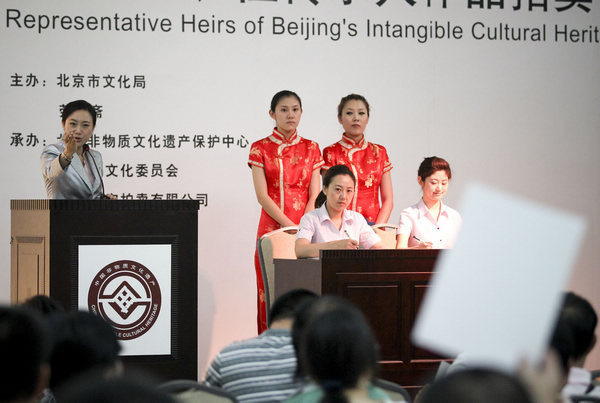Society
Auction gives hope to handicraft artists
By Han Bingbin (China Daily)
Updated: 2011-06-13 11:28
 |
Large Medium Small |
|
 An auctioneer gives a response on Sunday in Beijing to a bidder during the country's first large auction of artworks by masters of intangible cultural heritage. [Shi Chunyang / China Daily] |
Beijing - The country's first large auction of artworks made by masters of intangible cultural heritage proved a success on Sunday in Beijing, pushing ahead the effort to explore the handicraft market and attract young craft inheritors.
The Beijing Cultural Bureau, which hosted the auction, collected 86 pieces of artwork from 45 categories of city and national-level intangible cultural heritage. Tagged with reserve prices up to 800,000 yuan ($123,440), the artworks went on the block on Sunday.
|
||||
Qian Rong, an official with the cultural bureau, said the sale prices were "nice surprise" as the capital's traditional handicraft market has been sluggish during the past decade.
Gao Wei, secretary-general of the Beijing Folk Art Association, attributes this to two reasons.
First, the artistic value of traditional handicrafts is often underestimated. In addition to their appearance, Gao said, the value of these handicrafts is also from the tradition's associated history, which takes time for people to appreciate.
But they are also losing market value because of the appearance of cheaper mass-produced imitations.
"People often mistake the price of these cheaper pastiches as the real value of the handicraft genre they represent," Gao said. "But when referring to the artistic value of a handicraft, we mean time and labor-consuming handicrafts made by hand with meticulously chosen materials."
Both Qian and Gao were happy that the auction showed that some collectors already regard traditional handicrafts as a worthwhile art form to invest in and collect.
"When art collectors find no passion in other investments, I believe they'll come back to the traditional handicraft market," said Luo Jinbu, a retired manager who sold two art pieces in the auction for a total of 430,000 yuan.
"I believe the really good artworks are produced in modern times, because they are not only made by the most skilled labor and with the best materials, they also embody modern aesthetics. They are the precious antiques of the future," Luo added.
Qian said the next step is to let young people see what an optimistic future the business has.
"The ultimate goal is to demonstrate that these handicrafts have a real chance to be profitable, so that more young people will be willing to learn and pass down the workmanship."
Many handicraft forms are in the danger of dying out, because young people see no future in them.
Hua Shuling, the heir of Beijing silk figurines, said she has had over 100 apprentices, but now has just two. Even these remaining hopefuls, Hua said, are considering quitting because "this doesn't make money". Zhang Guoliang, the capital's kongzhu (Chinese yo-yo) master said his 200 apprentices were now reduced to eight.
| 分享按钮 |

